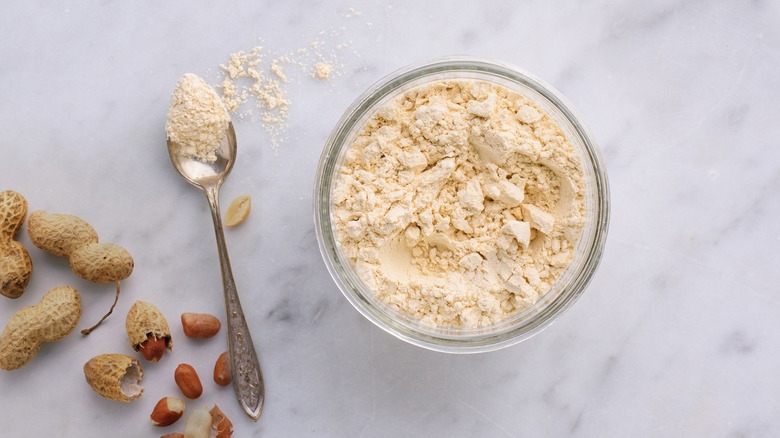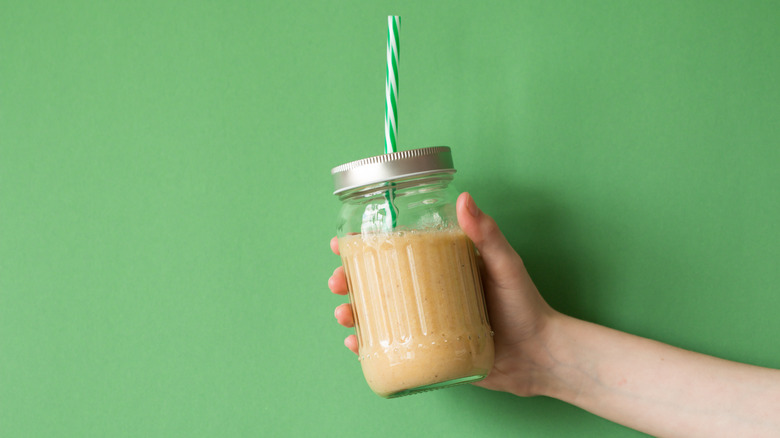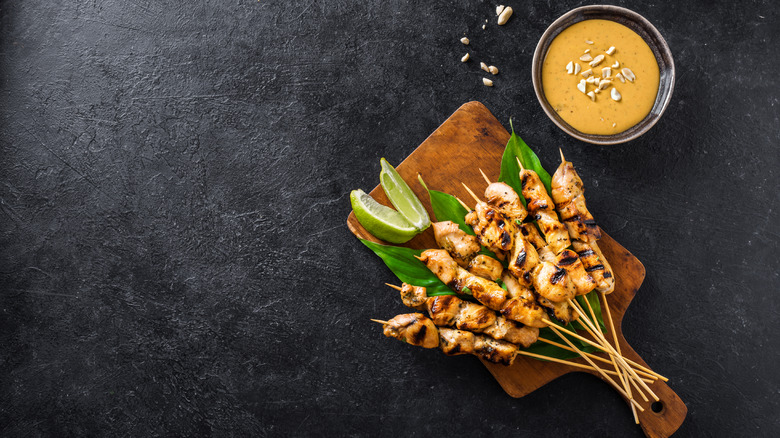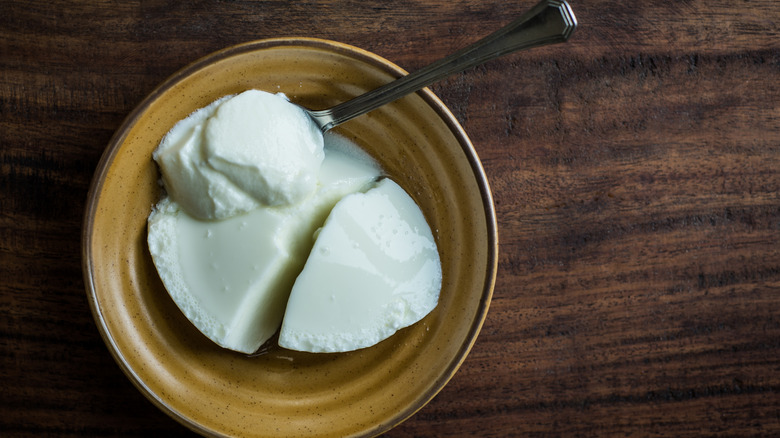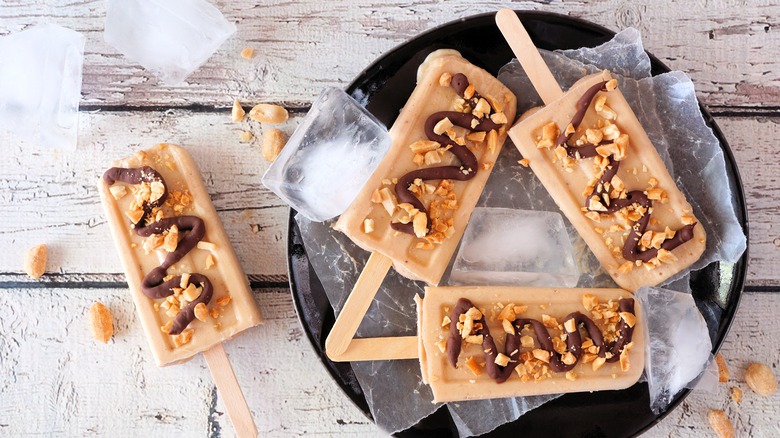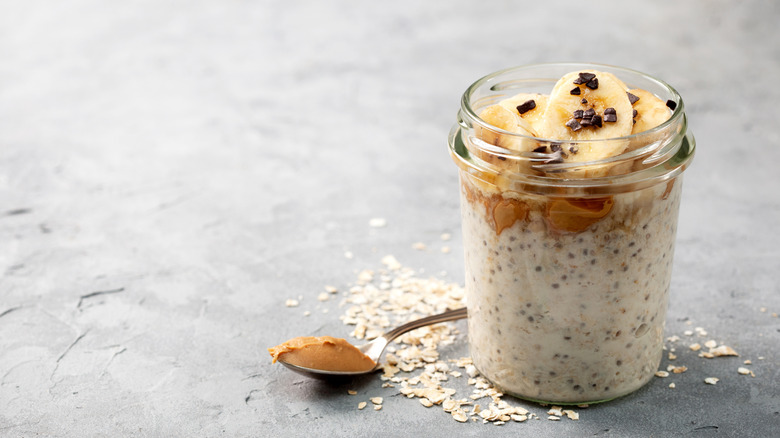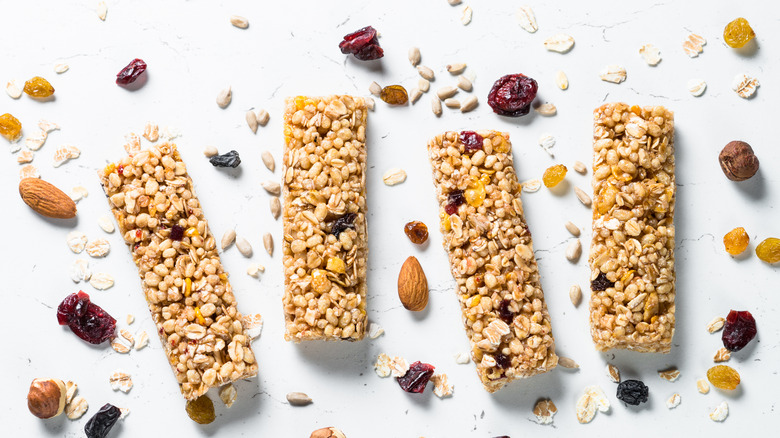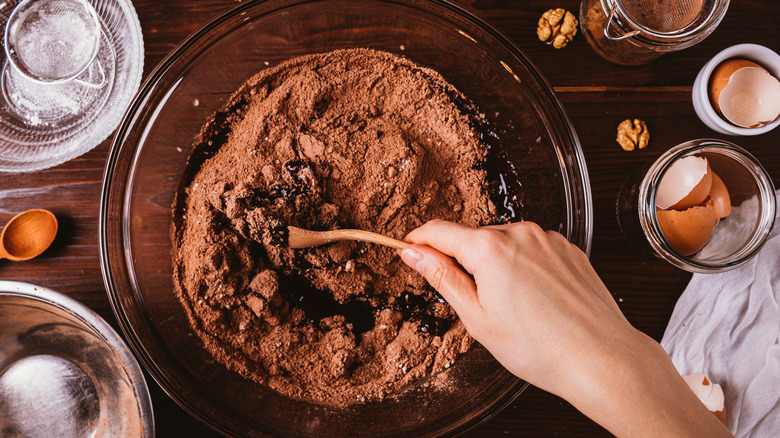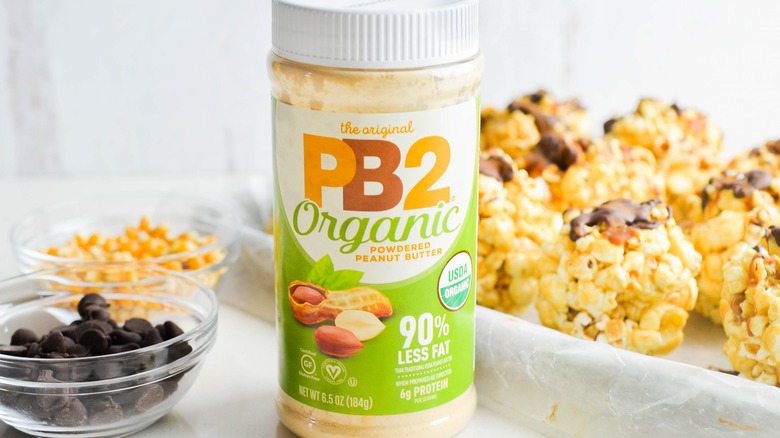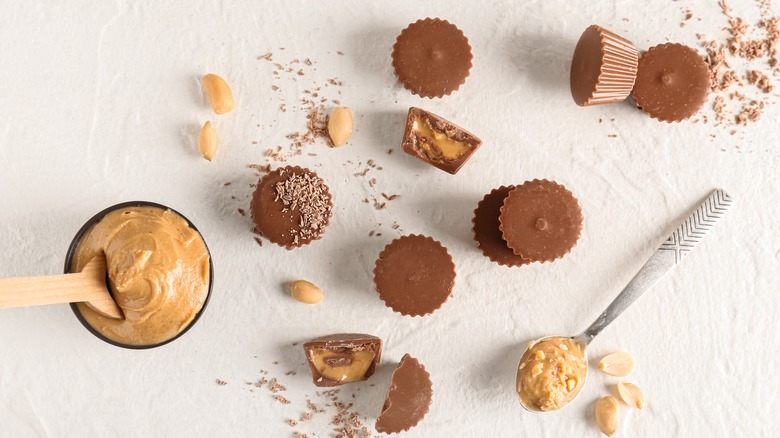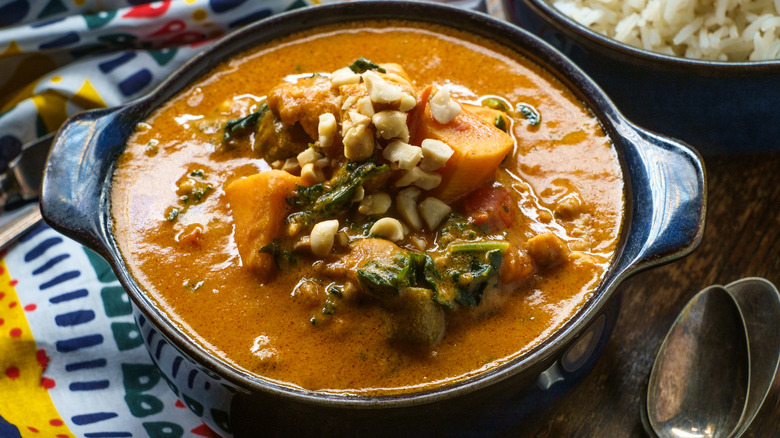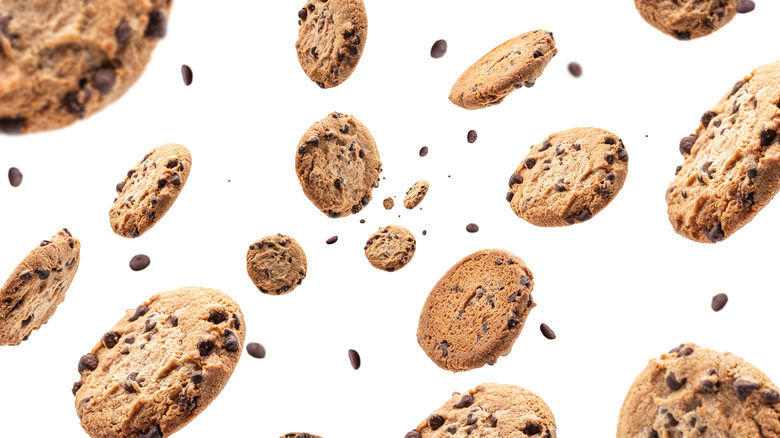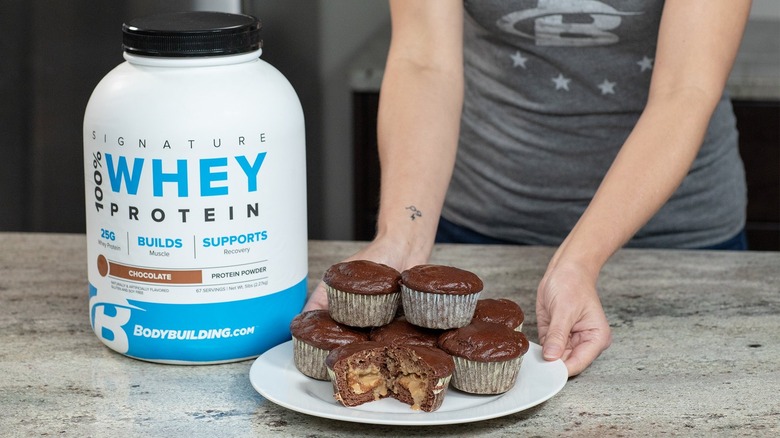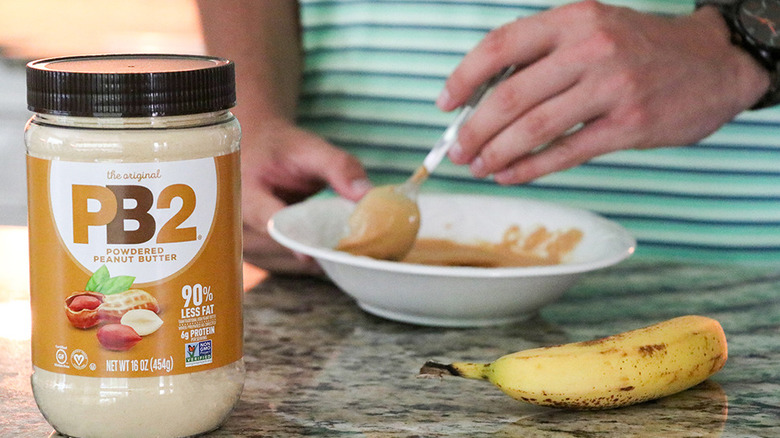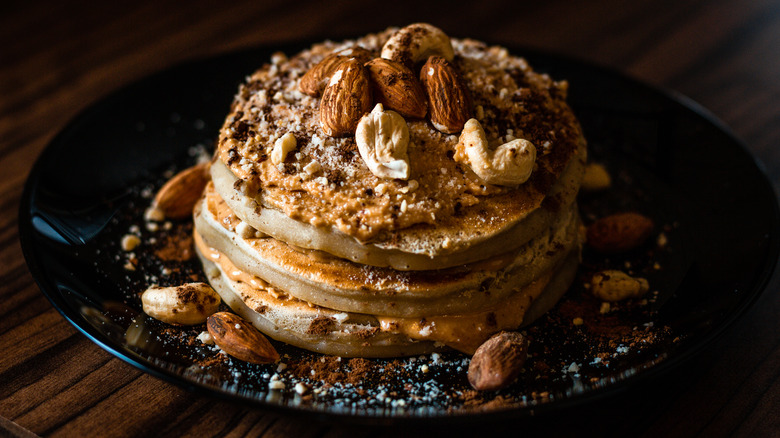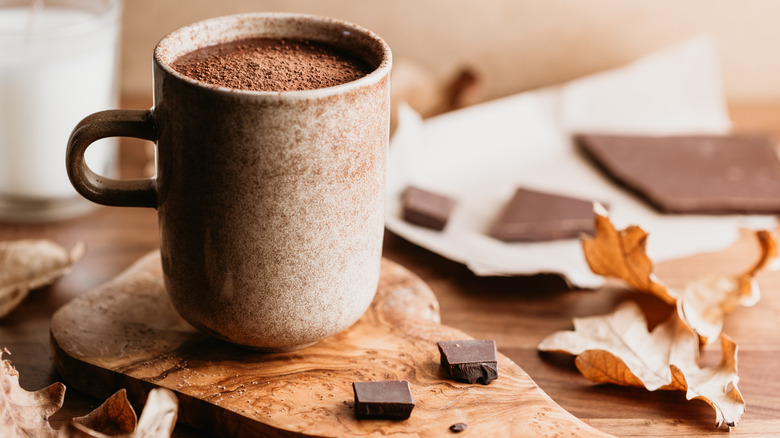The Absolute Best Uses For Peanut Butter Powder
We may receive a commission on purchases made from links.
The benefits of a high-protein diet have been well-researched by modern nutritional scientists: improved sparing of lean body mass, easier weight management, enhanced glycemic regulation, and increased calcium absorption, notes the Journal of Food Science. While many folks get their protein from a daily intake of meat, cheese, soy, and animal products, other folks turn to legumes like peanuts for their daily recommended amount. Peanuts and popular peanut byproducts, like peanut butter, provide nutrients beyond protein including fiber, carbohydrates, antioxidants, vitamins, and minerals. But, foods with peanuts are often high in fat — which in turn makes the foods high in calories.
But there is a way to obtain the same nutritional benefits of peanut butter without the high fat and calories: powdered peanut butter! According to PB2 Foods, powdered peanut butter is pressed to remove oils before being ground into a fine powder. The result is a product with 70% fewer calories and an astonishing 90% less fat than regular peanut butter. And the best part? You'll find almost the same protein and peanut flavor as regular peanut butter.
Peanut butter powder can be used in place of peanut butter in many recipes. Here are some of the best ways to use powdered peanut butter in your kitchen.
Add it to a milkshake
The peanut butter milkshake is a simple recipe at heart. Add a scoop of your favorite ice cream — either chocolate, vanilla, or peanut butter — to a blender with your milk of choice. When it comes to adding your peanut butter powder, you'll want to be sure to add a decent ⅓ to ½ cup; the flavor is not as pungent as using traditional peanut butter so it is important to add a significant amount if you want to actually taste the peanut butter.
When working with powdered peanut butter, be wary that you may need to add more milk to account for the use of a powder in the recipe. After blending the milkshake for a few minutes, scoop a bit of the shake out and taste for any residual powder. Add additional milk and continue pulsing if the peanut butter is still powdery. Top your milkshake with your favorite toppings; chocolate chips, crushed peanut butter cups, and a drizzle of peanut butter are perfect complements!
Make it into a peanut dipping sauce
Peanut sauce is a versatile dip in many Asian recipes. Pair a good peanut sauce with roasted chicken pieces, fried tofu, or raw spring rolls for a kick of flavor and peanut-y goodness. If you choose to use powdered peanut butter instead of regular peanut butter, you'll notice a much smoother and thinner texture.
When substituting peanut butter powder into a sauce recipe, you can either add the powder by itself or hydrate the powder into a paste (the preferred method) before adding it to the other ingredients. Adding the hydrated paste is a better option to control the consistency and flavors of the dish. Plus, you can always add more powder or water to hydrate or thicken the peanut butter as needed. For an additional hit of spice in your peanut sauce, add your favorite hot sauce or chili crisp. The heat pairs well with the richness of the peanut butter.
Make a high-protein dip with Greek yogurt
Greek yogurt has significantly more protein than traditional dairy yogurts, which makes the product a great post-workout recovery snack. And what better to do for more protein than add a bit of powdered peanut butter into your Greek yogurt?
When selecting a Greek yogurt for optimal nutritional benefit, try choosing an unsweetened and unflavored variety. Many yogurt companies add cane sugar or artificial sweeteners to their products. This can increase the calories per serving significantly.
Greek yogurt and peanut butter powder make a great high-protein dip for sliced apples, bananas, or pretzels. You don't even need to rehydrate the peanut butter before you stir it into the Greek yogurt. For an extra bit of sweetness, add a drizzle of honey or maple syrup to the top of the dip; if you're feeling adventurous, you might even add a sprinkle of chocolate chips. This snack is a great idea for folks looking to add more protein to their daily repertoire or parents looking for a healthy snack for their growing kids.
Make peanut butter popsicles
There might be nothing better than a cold popsicle on a hot summer day. Eating a popsicle made with peanut butter powder is a tasty treat with a hearty supply of protein.
You can use a pre-made protein shake to make a high-protein popsicle at home or use a base of yogurt (Greek or traditional) and milk. Adding a scoop of protein powder along with powdered peanut butter can boost protein significantly, but also result in a dry popsicle with pockets of powder. To avoid this issue, add extra milk and regularly taste the mixture for any grittiness. Use a high-speed blender to ensure that all the ingredients are well-incorporated before adding the popsicles to a mold.
If you want a chocolate surprise on the popsicles, add a chocolate shell drizzle to the mold before scooping the mixture in. This method is preferred as opposed to adding chocolate chips to the mixture because the chocolate chips usually settle in one part of the popsicle. Plus, chocolate chips are hard to chew when the chips are frozen solid.
Stir it into your overnight oats
Overnight oats were a food trend that took over the food and fitness scene a few years ago — and for good reason. Overnight oats have a soft, muesli-like consistency made by combining a 1-to-1 ratio of whole rolled oats to liquid. Cooks can choose to use water, milk, or dairy-free substitutes in their overnight oats, thus making the breakfast food adaptable to many different dietary adherences. Some folks will also choose to add yogurt to their overnight oats for additional protein and probiotics.
Overnight oats can be topped with granola, chia seeds, maple syrup, honey — and really anything you dream of. Peanut butter powder is an ideal complement to overnight oats because it does not result in the same gunky consistency as traditional peanut butter. Peanut butter powder can be stirred in the morning of or added when the oats are prepared the night prior. Stirring in peanut butter powder after the oats have soaked provides more control for the cook in the consistency of the oats than mixing the peanut butter powder the night before.
Make homemade granola bars
Granola bars are a simple snack that can provide a great source of on-the-go protein and fiber. Perhaps the best part about granola bars is that the recipe is freeform depending on your favorite flavors and ingredients. When making granola bars at home, you're looking for ingredients that are sticky to act as a binder and ingredients that are crunchy or chewy to add texture. Although maple syrup and honey are traditionally used as binders, egg whites can also provide a high-protein, low-sugar "glue" for the granola bar.
When working with powdered peanut butter, you'll want to reconstitute the powder before adding the rest of the ingredients. You'll want the peanut butter to be slightly stickier than a 1-to-1 ratio, so add less water and whisk until creamy. Brown rice syrup will also help other ingredients stick together in the batter. Add your favorite dried fruits, nuts, grains, and sweets to make your perfect granola bar.
Add a scoop to high-protein cookie dough
The antithesis of childhood (and probably adulthood too, if we're being honest) is stealing cookie dough batter out of the Tollhouse cookie bucket. Now, you can have your own safe-to-eat, high-protein cookie dough at home!
There are multiple ways to make cookie dough based on your dietary needs. For a plant-based cookie dough, blend a can of drained chickpeas in a high-speed blender with reconstituted peanut butter powder, plant-based milk, vanilla extract, sweetener, and a little bit of flour. We recommend using oat flour for its high fiber and protein, as well as its consistency as a binder. For even more protein, add a scoop of your favorite vegan protein powder.
Big Man's World recommends using casein, brown rice, or pea protein powder (as opposed to whey protein) to make cookie dough because of its strength and mild flavor. He also recommends refrigerating the cookie dough for at least 30 minutes before enjoying it for a more crumbly consistency.
Drizzle over popcorn
The problem with drizzling peanut butter over popcorn is that you never get the perfect amount; some kernels are covered, while others are missing any peanut butter essence. Using powdered peanut butter ensures that all of the kernels get at least some peanut butter flavor.
You can make traditional popcorn or kettle corn, but the one prerequisite is that the popcorn is hot and fresh. To make peanut butter kettle corn, heat kernels and fat (either butter or coconut oil) in a medium-sized pot. The trick with making popcorn is to constantly move the kernels to prevent burning, per Amy's Healthy Baking. After some of the kernels have popped, stir in the sugar and continue shaking until the kernels have popped. Once you have removed the heat from the popcorn, you can sprinkle your powdered peanut butter over the top of the kernels and shake to evenly spread the powder. Then, serve in a bowl with your favorite movie or beverage, and enjoy!
Make low-fat peanut butter cups
Peanut butter cups are a classic sweet treat. You can use powdered peanut butter to replace traditional peanut butter in homemade peanut butter cups for a delicious, low-fat substitute. You'll want to rehydrate the powder with a 1-to-1 ratio and stir vigorously to ensure that all the particles are rehydrated.
To make peanut butter cups at home, melt down your favorite chocolate with a bit of coconut oil. You'll want to stir the chocolate and the fat together so that it is well incorporated. Then, spoon the chocolate into lined cupcake tins or silicone molds. Be sure to completely cover the bottom of the tin before scooping the rehydrated peanut butter mixture into it. Spread the peanut butter evenly across the tin before sealing it with another layer of chocolate. For a modern flair, sprinkle flaky sea salt on top of the cups before refrigerating until solid.
Add powdered peanut butter to a stew or soup
Peanut stews are often found in African, Middle Eastern, and Indian recipes. Using peanut butter powder in lieu of peanut butter is a smart swap for both nutrition and flavor in these recipes. You'll want to use a 2-to-1 ratio of peanut butter powder to water for a peanut stew to create the same texture as traditional peanut butter. If you're making this substitution, it's also important that you use the same ratio of peanut butter to the rehydrated, 2-to-1 ratio peanut butter mixture to ensure the same consistency between the recipe variations.
Recipe developer Miriam Hanh recommends using ¼ cup of peanut butter in her recipe for a hearty peanut butter soup. The soup utilizes low-fat coconut milk and bulking vegetables like kale, sweet potatoes, red pepper, and red onion. You can garnish this soup with chopped peanuts and serve it with white rice for a cozy winter meal.
Bake a simple breakfast cookie
There might be no better combination than peanut butter and banana (unless chocolate is involved). With peanut butter powder, you can make a simple, low-fat breakfast cookie to grab on your way to work or class. You'll need three ingredients for these cookies: peanut butter powder, oats (either quick or old-fashioned), and mashed banana. The size of the banana will impact how much oats you add to the batter, so you're looking for a dough-like consistency that holds together when balled more than anything. Add a few tablespoons of the powdered peanut butter directly to the batter, along with any additional mix-ins like chocolate chips, cinnamon, or chopped peanuts. Scoop and flatten on a lined baking sheet.
You can bake these cookies at 350 F for about 15 minutes until solid. You may notice some color change, but the optimal bake will harden the cookies without burning them.
Substitute for protein powder
Protein powder is an important addition to breakfast. You should consider adding protein powder to your oats, smoothies, or bowls to suppress ghrelin (the hunger hormone). Eating a satiating breakfast will also result in more energy to power through your day.
If you find the taste of protein powder to be a bit repulsive (and you're not the only one), try substituting powdered peanut butter for a protein powder with a 1-to-1 ratio. Peanut butter powder is an excellent replacement for protein powder in baking because you won't have to change any of the ratios in the existing recipe to account for a drier batter. If the recipe does not include protein powder, you can consider substituting a small amount of the flour for powdered peanut butter. Mona's Table recommends substituting no more than one-quarter of the flour with protein powder. Be aware though that changing the ingredients in the recipe may result in a different texture or resulting bake; you may have to adjust the moisture levels in the batter or dough to keep the same hydration.
Rehydrate and use as normal peanut butter
Peanut butter powder can be easily rehydrated with your milk of choice for a soft, spreadable consistency. We recommend adding the liquid to the peanut butter powder very gradually — it can quickly go from being too grainy to too watery!
According to Shape, two tablespoons of reconstituted peanut butter and one tablespoon of liquid make about one tablespoon of nut butter. If you want a more drizzled consistency for cookies, increase the amount of water. For a more dense, chunky peanut spread, decrease the amount of water. You can also add chopped peanuts to the spread for an additional boost of fat and protein, as well as a textural element that you just don't get from the reconstituted powder.
Spread your reconstituted peanut butter on anything you'd use traditional peanut butter on — breakfast toast, PB & J sandwiches, or as a dip with fruit.
Add it to pancake or waffle batter
If you don't add peanut butter to your pancakes already, you need to start doing so. You may have never thought to use peanut butter in this iconic breakfast food, but the fattiness of the peanut butter pairs well with how filling pancake batter can be. Although rehydrated peanut butter powder is less dense than traditional peanut butter in a pancake or waffle recipe, we recommend adding fluffed egg whites to add extra air to the batter. Whisking egg whites for about two minutes (until stiff peaks form) and gently folding them into your pancake or waffle batter will make even more airy, decadent breakfasts for you and your family.
What we love about making peanut butter pancakes with powdered peanut butter is that you can use either homemade pancake batter or boxed pancake mix. Although rehydrated peanut butter can be substituted for a 1-to-1 ratio for traditional peanut butter, you can also use recipes that do not require reconstituting the powder before stirring it into the batter.
Add a scoop to your hot chocolate
There might not be any better combination on Earth than peanut butter and chocolate. The secret to making the best hot chocolate, besides adding a tablespoon of peanut butter powder, is to use whole chocolate rather than powdered mix. You should use a ratio of 3 ounces of chocolate to every 8 ounces (1 cup) of hot milk. You should also aim for steaming rather than scalding the milk to not only protect your tastebuds, but also the flavors and fats inside the beverage.
We recommend upgrading your peanut butter hot chocolate by adding the classic marshmallows as well as a drizzle of chocolate syrup or peanut butter to the top. Add sweeteners to your hot chocolate as needed, or try to make a totally plant-based drink by using oat-based or almond-based chocolate bars and dairy-free milk. If you're looking for a vegan marshmallow, you might check out your local Trader Joe's for its accidentally vegan marshmallows.
